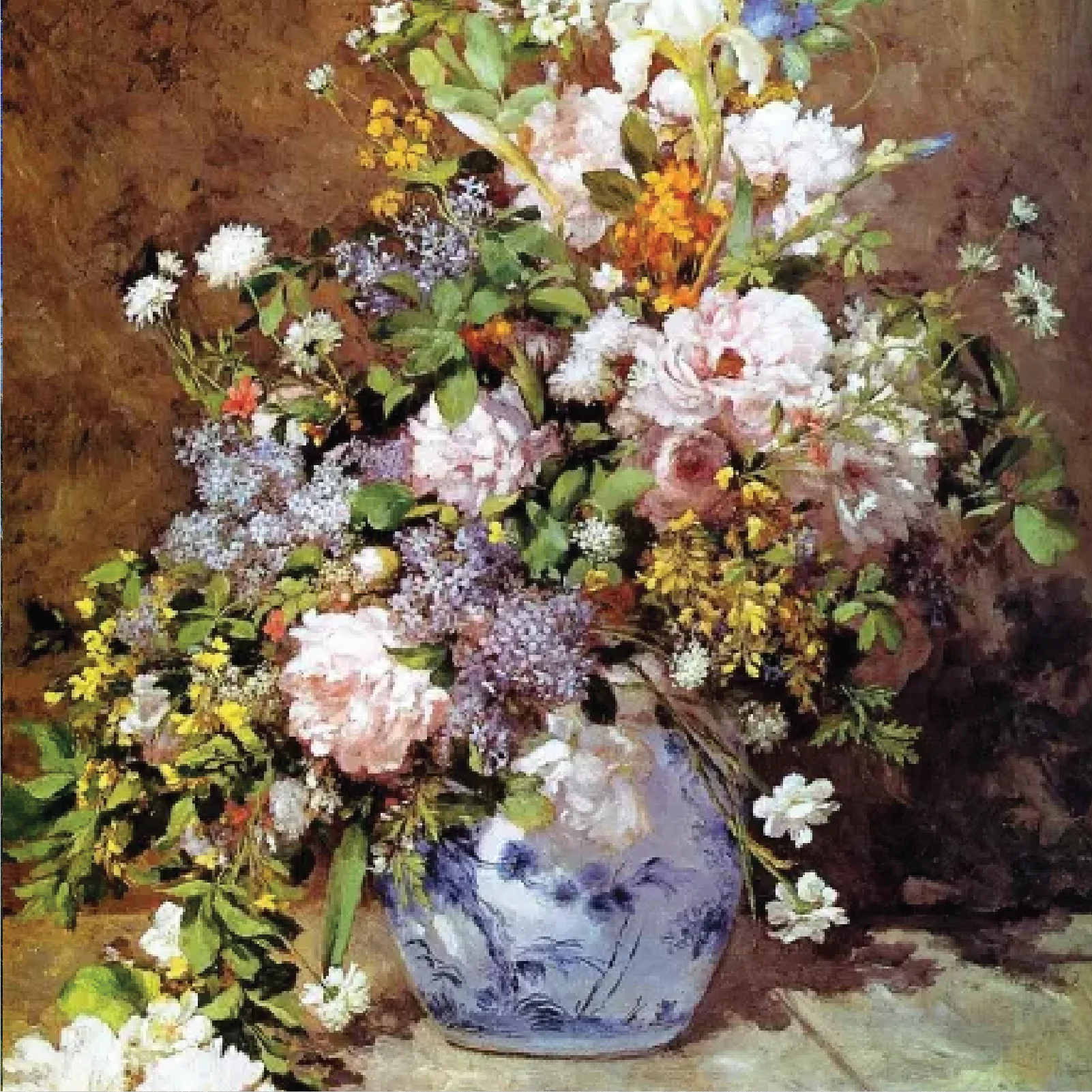Introduction
Selecting the right artwork for your home is more than just a finishing touch; it's a vital component of creating a space that feels uniquely yours. Art has the power to transform any room, infusing it with personality, emotion, and a sense of style. This guide will walk you through various aspects of choosing art that complements your home decor and resonates with your personal taste.
What does this guide cover?
- Understanding Personal Taste and Style: Discover how to reflect your individual aesthetics through art.
- Room Function and Mood Considerations: Learn how different types of artwork can enhance the function and mood of each room.
- Size, Scale, and Visual Balance: Get tips on achieving visual harmony with different-sized pieces.
- Color Palette Harmony in Artwork: Find out how to select artworks that complement your room's color scheme.
- Framing Styles and Presentation Options: Explore framing options that can elevate the presentation of your artwork.
- Mixing Styles and Textures for Visual Interest: See examples of successful displays featuring mixed media artworks.
- Investing in Art You Love: Understand the personal value beyond monetary investment.
- Shopping for Artwork: Learn where to find quality pieces, including online platforms like Art&See Oil Painting Reproductions.
- Placing and Displaying Artwork Effectively: Discover best practices for hanging art at the right height and lighting conditions.
- Curating Cohesive Art Collections: The benefits of creating collections that tell a story or have a unifying theme.
About Art&See
Art&See is a trusted source for exquisite oil painting reproductions. They specialize in recreating masterpieces from renowned artists, making high-quality art accessible to enthusiasts everywhere. Whether you're an avid collector or just beginning to explore the world of art, Art&See offers a wide range of options to suit your taste and decor needs.
Explore their blog for more insights on integrating art into your home.
By understanding these key elements, you'll be well-equipped to select artwork that not only beautifies but also personalizes your living space.
Understanding Personal Taste and Style
Personal taste plays a crucial role in choosing art. It's not just about picking what looks nice; it's about finding pieces that deeply connect with who you are and the atmosphere you want to create.
Exploring Your Existing Style
Looking at your current decor is a good starting point for understanding your personal style. Your home already tells a story through its furniture, color schemes, and decorative items. By examining what you already have, you can:
- Identify the elements that you love and want to incorporate into your art choices.
- Recognize any gaps or areas where you'd like to try something new.
This self-reflection will help guide you in selecting artworks that will harmonize with your space or make a bold statement.
Decoding Art Genres
To better understand what types of art you're drawn to, it can be helpful to explore different art genres. Here are a few examples:
- Impressionism: Known for its light brush strokes and vibrant colors, impressionist art can add a touch of whimsy and movement to any space.
- Realism: Realistic art appeals to those who appreciate detailed and lifelike representations. It often brings a grounded and sophisticated feel to the room.
- Abstract Art: Ideal for creating an energizing atmosphere with its bold lines and colors.
- Landscapes: Perfect for evoking tranquility and a sense of escape from daily hustle.
Each genre has its own unique qualities and emotional impact. By considering how different genres make you feel, you can choose artworks that resonate with your emotions and enhance the mood of your space.
For example, if you want to create a calm and peaceful bedroom, you might opt for a soothing landscape painting. On the other hand, if you're looking to add energy to a living room, an abstract artwork with vibrant hues could be the perfect choice.
Finding Inspiration
Sometimes it can be challenging to visualize how different art styles will look in your home. If you're unsure about certain genres or want to explore more options, online platforms like Art&See offer a wide range of oil painting reproductions for you to browse through.
Seeing these artworks in various settings can spark ideas and help you narrow down your preferences. Remember, the goal is not to copy someone else's style but to use these references as a source of inspiration for discovering your own unique taste.
By aligning your personal preferences with different art genres, you'll create an ambiance that truly reflects who you are.
Room Function and Mood Considerations
Selecting the right artwork for each room in your home can significantly influence the space's atmosphere. Different rooms serve different purposes, so understanding the function of each room helps in picking artworks that align with their intended mood.
Living Room
This is often a social hub. Energizing abstracts with bold colors can stimulate conversation and create a lively environment.
Bedroom
A sanctuary for rest. Calming landscapes or serene seascapes can promote relaxation and tranquility, perfect for unwinding after a long day.
Home Office
A place for focus and productivity. Inspirational quotes or minimalist art can help maintain concentration and creativity.
Dining Room
Where gatherings and meals take place. Still life paintings or vibrant contemporary pieces can enhance the dining experience and evoke warmth.
Examples of Artworks to Evoke Moods:
- Energizing Abstracts: Bold splashes of color, dynamic lines, and unconventional forms bring energy into communal spaces.
- Calming Landscapes: Soft hues, natural scenes, and gentle brushstrokes offer peace and relaxation in personal areas like bedrooms.
- Inspirational Pieces: Motivational quotes or minimalist designs that keep you inspired in workspaces.
- Vibrant Contemporary Art: Bright colors and modern designs to make dining areas inviting.
By considering the function of each room, you can select artworks that not only beautify your space but also enhance the mood you wish to cultivate.
Size, Scale, and Visual Balance
When choosing artwork for your home, it's important to think about the size and scale of the pieces. This can make a big difference in how they look in your space.
Why Size and Scale Matter in Artwork Selection
Here are a few reasons why size and scale are important when it comes to choosing artwork:
- Room Dimensions: The size of the room plays a role in determining the appropriate size of the artwork. In general, larger rooms with high ceilings can accommodate bigger pieces, while smaller spaces may benefit from more modestly sized art.
- Furniture Proportions: It's also important to consider the size of your furniture when selecting artwork. The art should complement the furniture rather than overpowering it. For example, a massive painting above a small sofa can look unbalanced.
Strategies for Achieving Visual Balance with Different-Sized Pieces
There are several ways you can create visual balance with artwork of different sizes:
- Gallery Walls: Combine various small to medium-sized artworks in a cohesive arrangement on a single wall. This technique can create a dynamic and visually engaging display.
- Statement Pieces: Use one large piece as a focal point in a room to draw attention and anchor the space.
- Symmetry and Asymmetry: Balance symmetrical arrangements (like two similarly sized pieces flanking a central object) with asymmetrical setups (like staggered heights or varied frame sizes) for creative flair.
Remember, the goal is to ensure that your chosen pieces work well with the overall aesthetic of the room. They should enhance the space rather than detracting from it.
"Balance is key in ensuring that your selected pieces harmonize with the space instead of clashing or appearing out of place."
Color Palette Harmony in Artwork
Color plays a vital role in achieving a harmonious decor. Selecting artworks that complement your room's color palette can create a cohesive and aesthetically pleasing environment. The key is to choose pieces that either match or thoughtfully contrast with your existing decor.
Tips for Analyzing Color Palettes
- Identify Dominant Colors: Look at the main colors in your room—walls, furniture, and major accessories. Choose artwork that incorporates these dominant shades to tie everything together.
- Consider Accent Colors: Don't overlook secondary colors. These can add depth and interest, making your space more dynamic.
- Use a Color Wheel: Complementary colors (those opposite each other on the wheel) can create striking contrasts, while analogous colors (next to each other on the wheel) offer a more subtle harmony.
- Neutral Balance: If your room features bold colors, neutral-toned art can provide balance. Conversely, vibrant artwork can enliven spaces dominated by neutrals.
Remember that color isn't just about matching; it's about creating an emotional connection and enhancing the room's overall vibe. Whether you prefer bold abstracts or calm landscapes, careful color choices will elevate your home’s decor.
Framing Styles and Presentation Options
When it comes to framing styles and presentation options, the right choice can make a significant difference in how your artwork is perceived.
Exploring Different Framing Options
- Classic Wood Frames: Timeless and versatile, wood frames are available in various finishes such as oak, walnut, and mahogany. They add warmth and sophistication to traditional artworks.
- Metal Frames: Sleek and modern, metal frames provide a minimalist look that pairs well with contemporary or abstract pieces. Options range from brushed aluminum to matte black finishes.
- Floating Frames: Ideal for canvas artworks, floating frames create an illusion of the artwork "floating" within the frame. This style adds depth and focus to the piece without overwhelming it.
- Ornate Frames: Intricately designed with elaborate details, ornate frames are perfect for classical or baroque art reproductions. They add a touch of grandeur and elegance.
Enhancing Presentation with Matting and Glass
- Matting: Adding a mat around your artwork can enhance its visual impact by providing a buffer between the art and the frame. Mats come in various colors and textures, allowing you to customize the presentation.
- Glass: Protecting your artwork with glass can prevent damage from dust and UV rays. Options include standard glass, anti-reflective glass, or acrylic glazing for added protection.
Considerations for Choosing Framing Styles
- Artwork Theme: Match the frame style to the theme of the artwork. For example, a rustic wooden frame complements pastoral landscapes.
- Room Decor: Ensure that the frame aligns with your home’s decor style to create a harmonious look.
- Personal Preference: Ultimately, choose framing options that resonate with your personal taste.
Framing styles and presentation options play a crucial role in showcasing your art in its best light, enhancing both its aesthetic appeal and longevity.
Mixing Styles and Textures for Visual Interest
Combining various artistic styles and textures can transform your home into a vibrant, eclectic haven that mirrors your unique personality. The practice of eclectic style involves mixing media—integrating oil paintings, sculptures, textiles, and more—to create visually stimulating environments.
Benefits of Mixing Styles and Textures
- Dynamic Visual Appeal: A blend of different art forms brings depth and character to any room.
- Personal Expression: Mixing styles allows you to showcase diverse aspects of your taste and experiences.
- Enhanced Texture: Integrating various textures, from smooth canvases to rough sculptures, adds tactile interest.
Examples of Successful Displays Featuring Mixed Media Artworks
1. Living Room Display
- Abstract Oil Painting: A large abstract piece as the centerpiece.
- Textile Wall Hanging: Adds warmth and texture.
- Metal Sculptures: Positioned on side tables for an industrial touch.
2. Bedroom Arrangement
- Impressionist Prints: Soft, calming visual tones.
- Wood Carvings: Earthy elements that complement the decor.
- Mixed Media Collage: Combines photographs, paint, and fabric for a cohesive yet varied look.
3. Home Office Setup
- Realism Paintings: Focused and detailed artworks to inspire concentration.
- Ceramic Pieces: Small vases or bowls for added texture.
- Digital Art Prints: A modern twist that balances traditional pieces.
Creating an eclectic style through mixed media not only enriches your home visually but also offers a unique platform for personal expression.
Investing in Art You Love
Understanding the Personal Value of Art Collections
Art collections can be deeply personal, reflecting your journey, tastes, and experiences. When you invest in art that resonates with you emotionally, it enhances your living space and provides a sense of fulfillment. This personal significance often outweighs any monetary value the artwork might hold.
Why It's Important to Invest in Pieces You Love Rather Than Solely for Financial Gain
Focusing on pieces that you genuinely love rather than those expected to appreciate in value ensures your collection remains meaningful. Art should evoke emotions, stir memories, or spark joy. Collecting based solely on potential financial return may lead to a disjointed collection that lacks personal resonance.
Identifying Value Beyond Monetary Terms
Considering the Cultural or Historical Importance of Artworks
Art's value isn't always about its price tag. Some pieces hold cultural or historical significance, representing a particular era, movement, or societal shift. For instance:
- Impressionist paintings capture the essence of light and color from late 19th-century France.
- Abstract works reflect the evolving nature of art in response to industrialization and modernity.
Understanding these contexts can deepen your appreciation and connection to the artwork.
Tips on Evaluating the Quality and Craftsmanship of a Piece
Assessing an artwork's quality involves more than just a visual examination. Here are some tips to guide you:
- Material: High-quality materials ensure longevity. Look for canvases with sturdy frames and use of archival inks or paints.
- Technique: Examine brushstrokes, texture, and detailing. Skilled artists often display precision and uniqueness in their technique.
- Condition: Check for damage like cracks, fading, or discoloration. Well-preserved pieces retain their aesthetic appeal over time.
For example, when considering an oil painting reproduction from Art&See, note how closely it replicates the original masterpiece’s details and textures.
Investing in art is as much about passion as it is about aesthetics. By focusing on personal significance and appreciating the intrinsic qualities of each piece, you create a collection that tells your story beautifully.
Shopping for Artwork: Where to Look
Finding the perfect artwork for your home can be an exciting journey. There are numerous avenues to explore, each offering unique benefits and opportunities.
Overview of Different Sources
When it comes to buying artwork, you have several options:
1. Galleries
Visiting local galleries allows you to see artworks up close and personal. It can be an enriching experience to view different styles and pieces in a curated environment.
2. Auctions
Auctions can be thrilling places to find high-quality, often rare pieces. They offer a dynamic atmosphere where you might snag a great piece at a competitive price.
3. Online Platforms
Websites like Art&See Oil Painting Reproductions provide convenient access to a wide range of artworks, including faithful reproductions of famous masterpieces. Online shopping offers the comfort of browsing from home and often presents a broader selection than local galleries.
4. Art Fairs and Markets
These events bring together diverse artists and styles in one place. It's a great way to discover new talent and buy directly from the creators.
Engaging with Artists and Ensuring Authenticity
Building relationships with artists can be incredibly rewarding. Here’s why engaging directly with artists is beneficial:
- Unique Finds: When you interact with artists, you have the chance to discover one-of-a-kind works that may not be available anywhere else. This adds a special personal touch to your collection.
- Insight into Creative Process: Learning about an artist’s inspiration and techniques can deepen your appreciation of their work. This connection makes the artwork more meaningful.
Tips for Verifying Authenticity:
- Always ask for provenance or documentation that verifies the history of the piece.
- For reproductions, ensure they are created by reputable companies like Art&See who use skilled artisans.
- If possible, consult with art appraisers or experts who can authenticate pieces before purchasing.
Exploring Online Platforms Like Art&See
Art&See Oil Painting Reproductions is an excellent online source for quality artwork. They specialize in reproducing famous master paintings, making it easier for art lovers to own pieces inspired by iconic artists. Here’s what makes them stand out:
- Variety: A vast collection of artworks spanning different genres and periods.
- Quality Reproductions: High standards in reproduction techniques ensure that every piece maintains the integrity of the original work.
- Convenience: Shopping online with Art&See means you can browse through collections at your own pace, read detailed descriptions, and make informed choices without leaving your home.
By exploring these various sources, engaging directly with artists, and ensuring authenticity, you'll find numerous possibilities to enhance your home's decor with beautiful artwork.
Placing and Displaying Artwork Effectively
When it comes to displaying artwork, hanging techniques and optimal placement are essential for showcasing your pieces beautifully. Here are a few tips:
Best Practices for Hanging Artworks
1. Height Matters
The general rule is to hang artwork so that its center is at eye level, which is typically around 57 to 60 inches from the floor. This ensures that the art is easily viewable without straining your neck.
2. Lighting Conditions
Proper lighting can enhance the beauty of your artwork. Use natural light where possible, but avoid direct sunlight which can cause fading. Consider installing picture lights or track lighting aimed at the artworks to highlight their features.
3. Spacing
When grouping multiple pieces together, leave about 2-3 inches between each frame. This spacing helps create a cohesive look and prevents the display from feeling cluttered.
Creating Focal Points with Art
Art is a powerful tool for creating focal points in a room. A well-placed piece can draw attention and anchor the space.
1. Making a Statement with a Single Large Piece
A single large artwork can serve as a dramatic focal point. It works well above furniture like sofas or beds, providing a striking visual impact.
- Above Sofas/Beds: Center the piece above these furnishings, leaving about 6-12 inches of space between the bottom of the frame and the top of the furniture.
- On Feature Walls: Use expansive walls to display large pieces. This can transform an empty wall into an engaging centerpiece.
2. Curated Arrangements of Smaller Artworks
Curating smaller pieces together creates an interesting and dynamic wall display. Here’s how to do it effectively:
- Gallery Walls: Arrange various sized frames in a balanced composition. Start by placing the largest piece in the center or slightly off-center and build around it.
- Themed Collections: Select artworks that share a common theme or color palette for coherence. This makes the display feel unified and intentional.
- Grid Layouts: For a more structured look, arrange artworks in a grid pattern. Ensure equal spacing between frames for symmetry.
Mixing these approaches throughout different rooms can create unique visual experiences that reflect your personal style while maintaining harmony within your home decor.
Curating Cohesive Art Collections
Creating an art collection with thematic coherence adds depth and continuity to your living space. When each piece in your collection tells part of a larger story, it becomes more than just a series of individual artworks; it transforms into a cohesive narrative that reflects your personal journey and taste.
Advantages of Curating Thematic Art Collections
1. Storytelling
A well-curated collection can tell a compelling story. Whether you're drawn to the serene beauty of landscapes or the dynamic energy of abstract works, selecting pieces that align thematically allows you to weave a visual tale throughout your home.
2. Visual Harmony
Consistency in theme helps maintain visual harmony. For example, if your collection focuses on impressionist flowers, the recurring motifs and colors create a soothing rhythm that ties different rooms together seamlessly.
3. Personal Expression
Curating with a unifying theme enables you to express specific facets of your personality or interests. If you're passionate about marine life, a collection centered around oceanic scenes showcases this love uniquely and cohesively.
4. Enhanced Aesthetic Appeal
Thematic collections often appear more polished and intentional, enhancing the overall aesthetic appeal of your space. This can make even eclectic decor feel thoughtfully assembled rather than haphazard.
5. Emotional Resonance
A thematic approach often brings emotional resonance. Art that speaks to you on a personal level can evoke memories, emotions, and thoughts, making your home not just visually pleasing but emotionally enriching.
Exploring art genres like realism or modernism within a chosen theme offers endless possibilities for creating a personalized yet coherent art collection that turns your home into an artistic haven.
Conclusion
Investing time in selecting artwork that reflects your personal style can significantly enhance the ambiance of your home. This guide has walked you through the essentials of understanding your taste, considering room functions, achieving visual balance, and more. Personalized home decor isn't just about filling walls; it's about creating a space that resonates with who you are.
Art&See Oil Painting Reproductions offers a fantastic avenue to find exquisite oil paintings crafted by talented artists. Their reproductions allow art lovers to bring the beauty of historical masterpieces into their homes without compromising on quality or authenticity.
- Discovering art that speaks to you: Art&See provides a range of options inspired by master artists, ensuring there’s something for every aesthetic preference.
- Craftsmanship and tradition: Each painting is meticulously crafted, preserving the essence of traditional art history while providing a modern touch to your space.
Embrace the principles outlined in this guide to curate an art collection that not only complements your home but also brings joy and inspiration every day.
FAQs (Frequently Asked Questions)
Why is selecting the right artwork important for my home?
Selecting the right artwork is crucial as it enhances the ambiance of your living space, reflects your personal style, and can evoke specific emotions. The right pieces can transform a room and create a cohesive decor theme.
How can I determine my personal art preferences?
To determine your personal art preferences, reflect on your individual aesthetics by considering existing decor in your home. Explore different art genres such as impressionism and realism, and think about the emotional connections you have with various artworks.
What factors should I consider regarding room function and mood when choosing artwork?
When choosing artwork, consider the function of each room and how you want to set the mood. Different types of artwork can evoke specific feelings; for example, energizing abstracts may be suitable for a lively space, while calming landscapes can enhance relaxation in bedrooms.
How do size and scale impact the selection of artwork?
Size and scale are important factors in art selection as they influence visual balance within a space. It's essential to choose pieces that fit proportionally with furniture and room dimensions to achieve harmony and avoid overwhelming or underwhelming the area.
What role does color play in selecting artwork for my home?
Color plays a significant role in selecting artwork as it should complement the room's color palette. Analyzing color schemes in both art and decor helps ensure that the chosen pieces enhance visual harmony throughout your living space.
Where can I find quality artwork for my home?
Quality artwork can be found through various sources including galleries, auctions, and online platforms like Art&See. Engaging directly with artists not only provides unique finds but also helps ensure authenticity in your art purchases.





























